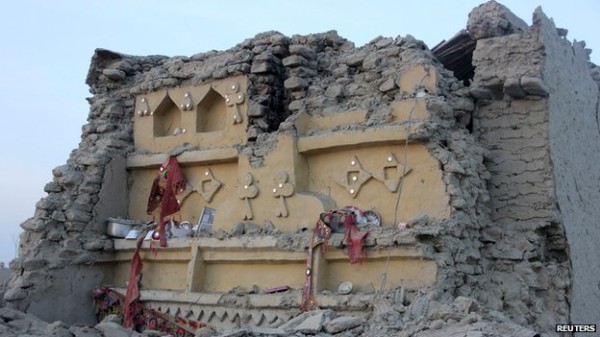
Many homes around Awaran have been reduced to rubble
A powerful earthquake has killed at least 208 people in Pakistan’s remote south-west province of Balochistan.
The 7.7-magnitude quake struck on Tuesday afternoon at a depth of 20km (13 miles) north-east of Awaran, the US Geological Survey said.
Many houses were flattened and thousands of people have spent the night in the open.
After the quake, a small island appeared off the coast near the port of Gwadar, witnesses reported.
People gathered on the beach to see the new island, which is about 9m (30ft) high and 100m long, Gwadar Police Chief Pervez Umrani said.
Balochistan is Pakistan’s largest but least populated province.
The region is prone to earthquakes, with at least 35 people killed in a 7.8-magnitude tremor that was centred in south-eastern Iran in April.

Mud houses
The latest quake was so powerful it was felt as far away as Karachi, Hyderabad, and India’s capital, Delhi.
Entire villages are reported to have been flattened in the impoverished and sparsely-populated district of Awaran.
Balochistan government spokesman Jan Buledi put the death toll at 208 for Awaran town and the surrounding villages only, and warned that it could rise. At least 340 people have been injured.
“We are seriously lacking medical facilities and there is no space to treat injured people in the local hospitals,” Mr Buledi said.
He said helicopters were airlifting the most seriously injured to Karachi while others were being cared for in neighbouring districts.
The army has sent more than 200 soldiers, medical teams and tents from the regional capital Quetta, but the mountainous terrain is said to be hampering the rescue operation.

Entire villages in the Balochistan district of Awaran are reported to have been flattened in the 7.7 earthquake

Most of the homes in the area are made from mud brick and easily collapsed when the tremors struck on Tuesday.

Many people spent the night in the open air, awaiting emergency relief supplies the army says it is sending from the regional capital Quetta.

The quake was so powerful it was felt across Pakistan and India. These office workers in Karachi were forced to evacuate their building.
Awaran local government official Abdul Rasheed Baluch said around 90% of houses in the district had been destroyed.
“Almost all the mud houses have collapsed. We have been busy in rescue efforts for the whole night and fear we will recover more dead bodies from under the rubble during daylight,” he said.
Many of the casualties are said to be from Labach, on the northern outskirts of Awaran town.
Houses are also reported to have caved in in the district of Khuzdar.
People in the region mostly live in mud houses as opposed to multi-storey concrete structures, says the BBC’s Shahzeb Jillani.
The few concrete buildings in the area mostly house government offices, he adds.
An emergency has been declared in Awaran and another earthquake-affected district, Chagai.



Leave a reply